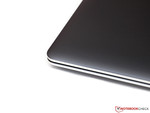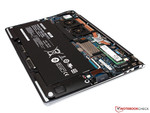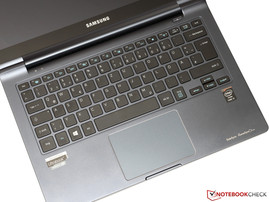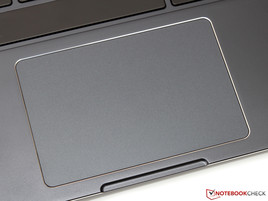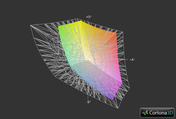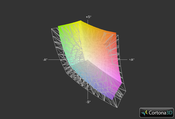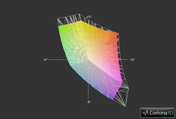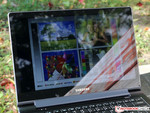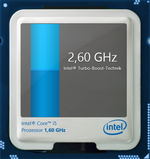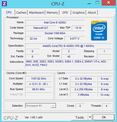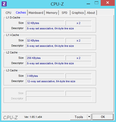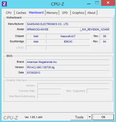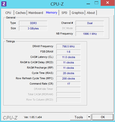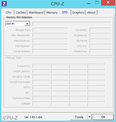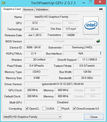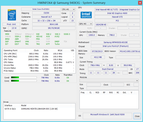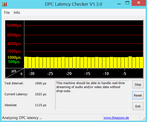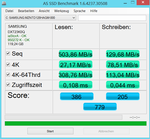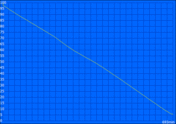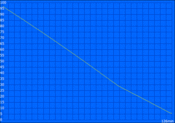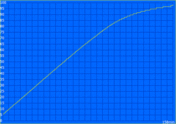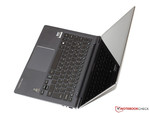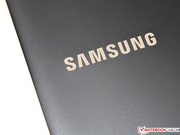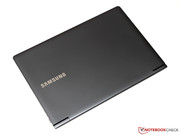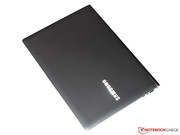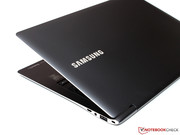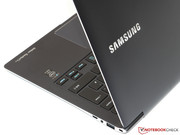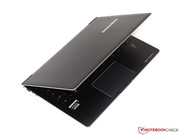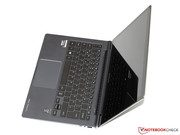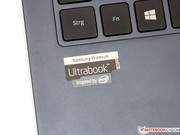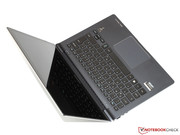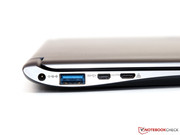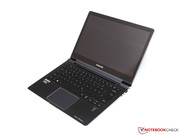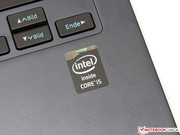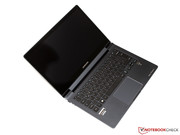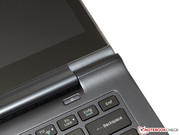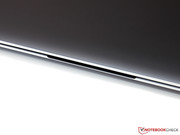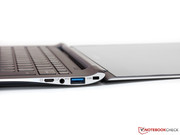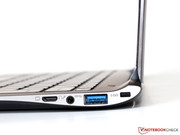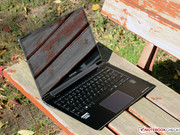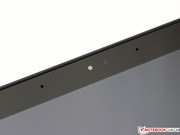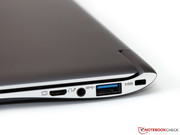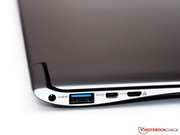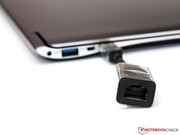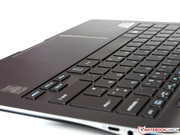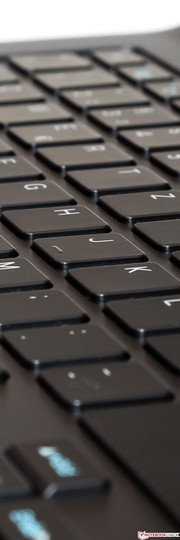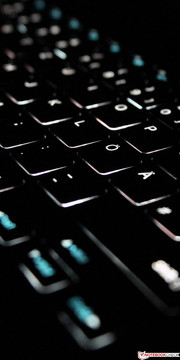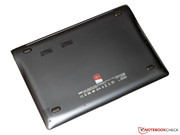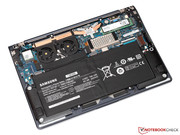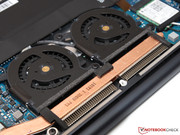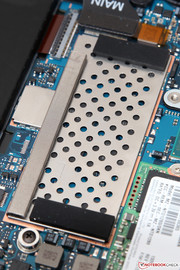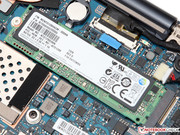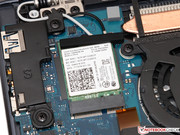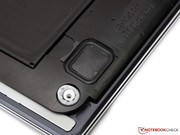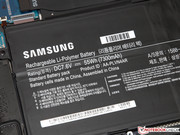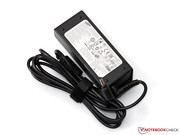Review Samsung ATIV Book 9 Plus 940X3G Ultrabook

For the original German review, see here.
Anyone looking for a slim ultrabook in the 13-inch category really cannot complain about not having enough options. Virtually every major manufacturer has a whole range of different models in their lineup, although only very few stick out from the masses with special highlights.
At first glance, Samsung's new ATIV Book 9 Plus also seems to lack such a unique trait. A Haswell-based Core i5-4200U alongside 4 GB of working memory and a 128 GB SSD corresponds to the typical equipment of a current mid-range ultrabook. Except for the screen that is. While some contenders do not even support a Full HD resolution of 1920x1080 pixels, Samsung is two steps ahead and relies on a touchscreen with ultra-high 3200x1800 pixels. This is likely also one of the main reasons for the extremely self-confident purchase price of just over 1300 Euros, ~$1757 (RRP: 1499 Euros, ~$2025).
But will a high-end screen be enough to challenge the competition? Premium devices, such as Sony's Vaio Pro 13, Apple's MacBook Air 13 or Acer's Aspire S7, lure buyers with their very own special qualities. Let us find out whether Samsung can compete with those.
Case
The manufacturer self-confidently calls the ATIV Book 9 "Premium Ultrabook" that is to enthrall with both the highest quality and elegant design. Matte-black aluminum surfaces alongside the curved shape ensure modern and stylish looks that impressively underpin Samsung's claim.
The generous use of light metal is not only for the looks. It would hardly have been possible to achieve the slim build with a thickness of just 13.6 millimeters and a weight of just below 1.4 kilograms - at least not without dire sacrifices in rigidness and stability. The 940X3G does not have these problems. The casing defies even high selective pressure without batting an eyelid. The stiff display makes an equally outstanding impression. It is held by a smooth-running yet very accurately working hinge that has a wide opening angle (approx. 180 degrees).
As to build, no minor or major flaws were discovered even under the most scrutinizing examination. Perfectly fitted material transitions - which are few owing to the unibody casing - and carefully rounded edges are evidence of the meticulous quality control through which Samsung sends its flagship. Even the MacBook series frequently used as a reference cannot do that much better.
Connectivity
Ultrabooks are not typically known for having a stunning array of interfaces, which can usually be tolerated in a portable (secondary) laptop. The ATIV Book 9 buyer can nevertheless take delight in two USB ports that support the current USB 3.0 standard. A micro-HDMI (up to a max of 4096x2160 pixels) and a VGA out that can only be used with an additional, not included adapter are also installed. However, the matching dongle for the mini-LAN port is included.
All interfaces, including a headset jack and a Slim Security Lock (not compatible with a Kensington lock) are easy to reach in the rear area of both sides. Only the SD card reader has been placed a bit adversely and can barely be found without lifting the laptop.
Communication
The Wireless-N 7260 Wi-Fi adapter in the 940X3G comes from Intel. As the name suggests, the module supports IEEE 802.11 a/b/g/n wireless network standards and operates in both the 2.4 and 5 GHz bands. It is, however, a bit too bad that Samsung did not install the insignificantly more expensive high-end Wireless-AC 7260 model that supports 802.11 ac. Thus the gross data rate achieves a maximum of 300 Mbit/s rather than up to 876 Mbit/s, providing that a dual-stream capable router (2x2) is used. Apart from this minor drawback, the wireless module compels with a very stable connection, good range and useful features such as Wireless Display and Bluetooth 4.0 support. Unfortunately, an integrated UMTS/LTE adapter is generally not available.
The 0.9 megapixel webcam intended for video calls and snapshots offers an identically modest quality as the cameras in most other contenders. The picture is very noisy and only displays few details particularly in unfavorable light. This might be enough for communication purposes but even low-priced smartphones normally shoot nicer pictures. The complementary array microphone does a somewhat better job. Its voice recordings are still loud and clear even from a larger distance.
Accessories
The ATIV Book 9 Plus is delivered in a rather small box. Apart from the laptop, it only includes the matching 40 watt power supply, a few leaflets and the aforementioned Ethernet adapter. All other extras are preinstalled programs that range from superfluous (various adware apps) to more or less useful (trial version of Norton Internet Security). A nice gimmick for owners of a Samsung smartphone is the so-called SideSync Tool that allows using the phone as a remote for the laptop's screen.
Maintenance
Opening the laptop's underside is agreeably simple. The base plate can be lifted off easily after removing a few screws (PH 00). While the memory and CPU are soldered, the wireless module and battery can be taken out effortlessly. The SSD could basically also be replaced but the necessary M.2 cards are currently difficult to get. It is also recommendable to clean the well-accessible fan and heat sink regularly from dust and other impurities.
Warranty
Samsung includes a 24 month manufacturer's warranty that can, as usual, be upgraded for a surcharge. Different online stores offer corresponding upgrade bundles that range from about 75 Euros (~$101, 3 year bring-in service) to 250 Euros (~$337, 5 year on-site service).
Input Devices
Keyboard
The black chiclet keyboard is slightly submerged into the ultrabook's aluminum chassis. The approximately 15 x 15 millimeter keys are illuminated by an adaptable multi-level backlight and feature a sleek yet sufficiently non-slip surface. The manufacturer fortunately omits unnecessary layout gimmicks and thus only a short familiarization period is required.
Although the key drop is a bit too short for our taste, the typing feel is overall compelling. The crisp, accurate pressure point provides clearly palpable feedback which underpins the first-rate impression. Nothing wobbles, clatters or yields; the used plastic is well-processed and supplies a quality feel.
Touchpad
The Elan SmartPad enclosed by an elegant rim has a generous size of 10.2 x 6.8 centimeters and resembles the touchpads found in older Series 9 laptops. Owing to its slick surface and extremely high responsiveness, the mouse cursor can be moved just as accurately and quickly as otherwise known from external inputs. Multitouch gestures via two, three or four fingers additionally facilitate its use and the single gestures can be disabled when required.
Like in other ultrabooks, the user will not find dedicated mouse buttons. These inputs are triggered by direct pressure on the touchpad's corresponding side. The well-defined stroke is absolutely reliable up to the edges and provides a rich but not too loud click-noise.
Touchscreen
In line with the updated ultrabook specifications, the ATIV Book 9 Plus is only available with a capacitive 10 finger touchscreen. It implements all inputs responsively and without delay although most users will likely use a mouse and keyboard. This also applies to comparable competition models that do not feature a removable or foldable screen.
Display
Apple was considered to be the pioneer in terms of screen resolution in former years but now other manufacturers are setting standards in this field. After various contenders have surpassed the highly praised Retina screens of the iPad and iPhone, the MacBook Pro is now also dethroned in the 13.3-inch category. With an awesome 3200x1800 pixels and 276 dpi, Samsung's ATIV Book 9 Plus features the highest resolution and the sharpest laptop screen that we have ever tested.
However, we have to add a large "but". Windows 8 simply is not designed for such a high pixel density. Many elements are difficult to recognize from a normal distance even when using maximum scaling settings and thus Samsung recommends an interpolation of 1920x1080 pixels. The user should wait for the soon available free update to Windows 8.1 for the full QHD+ resolution.
According to the spec sheet, the screen achieves a high brightness of 350 cd/m². However, we cannot quite confirm this in our measurements. The ascertained 284 cd/m² is not bad and is just below that of the MacBook Pro 13 Retina, but a somewhat stronger backlight would be appreciated in view of the screen's glare-type surface.
| |||||||||||||||||||||||||
Brightness Distribution: 84 %
Center on Battery: 301 cd/m²
Contrast: 772:1 (Black: 0.39 cd/m²)
ΔE Color 4 | 0.5-29.43 Ø5
ΔE Greyscale 4.4 | 0.57-98 Ø5.3
54.8% AdobeRGB 1998 (Argyll 1.6.3 3D)
Gamma: 2.43
The screen from Samsung's own product line is based on the so-called PLS technology. Its properties are similar to that of a conventional IPS screen. The black value of 0.39 cd/m² and contrast ratio of 772:1 are consequently on the same high level as the competition and ensure a rich and vivid image impression.
Users planning to use the 940X3G for graphic or image editing will be satisfied with a decent though not quite perfect color reproduction. The screen is fairly well-calibrated ex-factory and only shows minor deviations in colors (DeltaE: 4.0) and grayscales (DeltaE: 4.4). The crucial sRGB color space is covered to 75% which should usually suffice for non-professional users.
Update 10/05/2013: A reader pointed out that the color reproduction differs in AC and battery mode. The brightness and intensity of different colors, in particular those with a large yellow part, decrease when disconnected from the outlet and the picture looks a bit paler. This effect cannot be countered even over the various energy-saving and brightness settings (including the adaptive brightness control) in the graphics driver. In our opinion, this issue is not particularly adverse in routine use and barely noticed in most cases. We will inform our readers as soon as this is resolved.
Update 11/10/2013: The problem has been resolved by a new graphics driver.
Visible reflections are particularly an issue outdoors due to the glare-type screen. They do not completely disappear even in maximum screen brightness. Nevertheless, it is well possible to work with the device on the go when the user avoids direct midday sun. However, a matte screen without touch would considerably upgrade the ATIV Book in our opinion although this would strip the device of the ultrabook title.
The assessment of the viewing angle stability closes this chapter. To make it short, the PLS screen does not exhibit any weaknesses here and barely any losses in picture quality become evident even in extremely acute viewing angles. Screens based on TN, such as the MacBook Air 13, score considerably worse in this exercise but are also considered to be a bit more economical and significantly less expensive.
Performance
Samsung initially sells the ATIV Book 9 Plus in only one configuration based on a Haswell Core i5-4200U. The energy-efficient 15 watt processor clocks with a low 1.6 GHz but can achieve rates up to 2.3 GHz (two cores) or 2.6 GHz (one core) via Turbo Boost 2.0 - providing that the power consumption and temperature do not exceed the specified limits. Among other things, the feature set incorporates the new AVX2 instruction set, AES-NI encryption acceleration and Hyper Threading technology known from former models.
Like many other ultrabooks, the 940X3G does not sport a dedicated graphics card and relies only on the processor-integrated, DirectX 11 capable HD Graphics 4400. We will examine to what extent this low-end chip is suitable for the extremely high screen resolution later in the review.
The rather meager memory configuration is surprising in view of the price category. It only encompasses 4 GB of DDR3 RAM (800 MHz, dual-channel) and a 128 GB SSD. Samsung has not yet conclusively decided whether other models will be available in future. However, the purchase price will likely quickly increase by several hundred Euros with 8 GB of RAM, 256 GB SSD and Core i7.
Processor
The Core i5-4200U easily achieves its maximum Turbo clock and consequently the expected performance level. Nevertheless, 1.14 (single-thread) and 2.49 points (multi-thread) in Cinebench R11.5 only equals a modest advantage of 5% over the former Core i5-3317U model - this difference is barely noticed in everyday use.
Would using a faster ULV CPU, such as the Core i7-4500U, change this fundamentally? Only to an extent. The Vaio Pro 13 fails due to the increased heat dissipation and even delivers somewhat lower performance scores. However, when the larger Turbo margin could be maxed out ideally, the possible plus would only be approximately 15%. Whether the possible surcharge is really worthwhile - providing Samsung adds a corresponding model to the lineup - is ultimately up to the buyer.
Storage Devices
The trend toward increasingly thinner ultrabooks makes it difficult for even 2.5-inch drives to find room in the casings. Consequently, Intel invented the new M.2/NGFF standard that is to make especially small, energy-efficient and swift flash memories possible. Currently, they are still mostly connected via the SATA 3.0 protocol which limits the transfer rate to around 550 MB/s.
The Samsung MZNTD128HAGM SSD installed in the 940X3G, presumably a derivative of the SSD 840 series that is also available in larger formats, comes very close to this maximum rate. The storage device transfers roughly 500 MB/s over its interface in sequential read. However, the write speed is only 130 MB/s. A larger 250 GB model would likely be considerably faster here. The scores of the different 4K tests are practically just as important and our review sample finishes these with excellent rates.
System Performance
A strong processor and swift SSD are the most important ingredients for an efficient overall system. An impressive 4912 points in PCMark 7 secures the ATIV Book a leading position in the field of contenders and again proves that it doesn't always have to be an expensive Core i7 processor. In our opinion, another upgrade would be more important. 4 GB of working memory might be enough for most routine applications, but it quickly finds its limits in intensive multitasking or complicated image editing. Doubling this capacity would certainly look more impressive in a self-proclaimed Premium Ultrabook. Disregarding this minor drawback, the general performance does not give reason for complaint. The system excels with very short booting and loading times and quickly responds to a user's commands at all times, which is particularly due to the SSD.
| PCMark 7 - Score (sort by value) | |
| Samsung ATIV Book 9 Plus | |
| Sony Vaio Pro 13 SVP-1321C5ER | |
| Apple MacBook Air 13 inch 2013 MD760D/A | |
| Acer Aspire S7 391-73514G25aws | |
| Dell XPS 12 Haswell | |
| PCMark 7 Score | 4912 points | |
| PCMark 8 Home Score Accelerated | 2449 points | |
| PCMark 8 Creative Score Accelerated | 2425 points | |
| PCMark 8 Work Score Accelerated | 4154 points | |
Help | ||
Graphics Card
The HD Graphics 4400 is based on the intermediate expansion stage of the Haswell GPU (GT2) that integrates a total of 20 Shader Clusters or Execution Units (EUs). In favor of low power consumption, the chip only clocks with 200 - 1000 MHz but promises a certain amount of more performance in contrast to the older HD Graphics 4000. This is very clear in the synthetic 3DMark 11 but that is just as true for the backlog compared with the HD Graphics 5000 or a dedicated Radeon HD 8570M.
Besides the 3D performance, we also asked ourselves whether the high-resolution screen overpowers the HD 4400's reserves in Windows operation. We can allay such concerns. No disturbing stutters while moving windows, scrolling or similar actions were noticed even in the native resolution of 3200x1800 pixels. Also, 4K trailers were rendered smoothly both via MediaPlayer and YouTube.
| 3DMark 11 - 1280x720 Performance GPU (sort by value) | |
| Samsung ATIV Book 9 Plus | |
| Dell XPS 13 L322X | |
| Apple MacBook Air 13 inch 2013 MD760D/A | |
| Samsung 730U3E-S04DE | |
| 3DMark 06 Standard Score | 5751 points | |
| 3DMark Vantage P Result | 4046 points | |
| 3DMark 11 Performance | 931 points | |
| 3DMark Ice Storm Standard Score | 34075 points | |
| 3DMark Cloud Gate Standard Score | 4314 points | |
| 3DMark Fire Strike Score | 625 points | |
Help | ||
Gaming Performance
The potential buyer should give up any dreams of playing games in the maximum resolution. Even high-end accelerators, such as the GeForce GTX 770M, would fail with current titles. However, the HD Graphics 4400 easily renders low to medium settings and 1024x768, and sometimes even 1366x768 pixels, usually with over 40 fps. Apart from 3DMark and co., it proves to be secondary that Samsung did not install a CPU with the marginally stronger HD Graphics 5000. The difference between both GPUs shrinks to almost zero with an identical memory interface.
| Samsung ATIV Book 9 Plus HD Graphics 4400, 4200U, Samsung MZNTD128HAGM | Dell XPS 12 Haswell HD Graphics 5000, 4650U, Liteonit LMT-256M6M | Dell XPS 13 HD Graphics 4000, 3517U, Samsung SSD PM830 256 GByte mSATA | |
|---|---|---|---|
| Diablo III | 1% | -11% | |
| 1024x768 Low / off | 55.8 | 59 6% | 56 0% |
| 1366x768 Medium / low | 37.9 | 38 0% | 32 -16% |
| 1366x768 High AA:on | 31.7 | 31 -2% | 26 -18% |
| Anno 2070 | 2% | -31% | |
| 1024x768 Low Preset | 62.5 | 61 -2% | 45 -28% |
| 1366x768 Medium Preset AA:on | 28.8 | 30 4% | 19 -34% |
| 1366x768 High Preset AA:on AF:2x | 17.1 | 18 5% | 12 -30% |
| Total Average (Program / Settings) | 2% /
2% | -21% /
-21% |
| low | med. | high | ultra | |
| Anno 2070 (2011) | 62.5 | 28.8 | 17.1 | |
| Diablo III (2012) | 55.8 | 37.9 | 31.7 | |
| Dota 2 (2013) | 54.5 | 33.1 | ||
| Total War: Rome II (2013) | 34.7 | 27.5 | 19.9 | |
| Fifa 14 (2013) | 153.8 | 89 | 67.1 | 41.8 |
Emissions
System Noise
The even further reduced power consumption of the Haswell platform enables cooling the ultrabook completely passively in idle. Since the SSD drive does not produce any noise, an absolutely silent operating noise of just 29.6 dB(A) is achieved. This is also true for many routine tasks, such as Office or HD video playback.
A few seconds pass before both fans increase their speed step-by-step after starting particularly demanding applications. We ascertained a maximum level of 41 to 42 dB(A) which places the ATIV Book 9 Plus on the same level as contenders like the MacBook Air 13 or Dell XPS 13.
Noise Level
| Idle |
| 29.6 / 29.6 / 29.6 dB(A) |
| Load |
| 41.4 / 42.4 dB(A) |
 | ||
30 dB silent 40 dB(A) audible 50 dB(A) loud |
||
min: | ||
Temperature
The temperature development also proved to be quite unremarkable. The consistently cool wrist rest even during maximum load has to be highlighted. However, the device's rear area, where the processor and heat sink are located, heated up much stronger. The surface temperatures partly reached over 47 °C which is not an unusual rate for an ultrabook. Of course, the casing does not heat up to such an extent in routine use and can be placed on the lap without hesitation.
The Core i5-4200U throttled to 1.2 GHz during our stress test but this is not temperature-related. The chip tries to reserve as much of the limited power budget for the graphics unit, which rewards this with a decent Turbo boost of 900 MHz. At the same time, the core temperatures only climbed to an uncritical 75 °C so that the user does not need to fear overheating in midsummer. The 3DMark test performed directly afterward delivered a good score that barely differs from the prior, ascertained rates.
(-) The maximum temperature on the upper side is 47.2 °C / 117 F, compared to the average of 35.9 °C / 97 F, ranging from 21.4 to 59 °C for the class Subnotebook.
(-) The bottom heats up to a maximum of 47.3 °C / 117 F, compared to the average of 39.4 °C / 103 F
(±) In idle usage, the average temperature for the upper side is 32.4 °C / 90 F, compared to the device average of 30.7 °C / 87 F.
(+) The palmrests and touchpad are reaching skin temperature as a maximum (35.2 °C / 95.4 F) and are therefore not hot.
(-) The average temperature of the palmrest area of similar devices was 28.3 °C / 82.9 F (-6.9 °C / -12.5 F).
Speakers
Not many ultrabooks exist that can compete with the clear and rich sound of the speakers integrated into the ATIV Book. Both stereo speakers radiate their sound toward the tabletop and render the entire bandwidth of brilliant trebles up to - for laptop conditions - a very strong bass that even lets the table vibrate noticeably. The small speakers naturally cannot compete with an external sound system, connected via HDMI or the jack but the provided quality is absolutely sufficient for occasional movie or music enjoyment.
Energy Management
Power Consumption
When idling, the 940X3G is satisfied with a low 4.7 to 9.0 watts and undercuts the former, Ivy-Bridge based model by approximately 3 watts. However, somewhat more energy-efficient ultrabooks exist with a minimum power consumption of only 2.7 watts, e.g. Sony's Vaio Pro 13. This difference is likely due to the screen's higher resolution, but also possibly due to different SSDs, power supplies and other components.
Neglecting such influencing factors, the full load power consumption of 30.9 to 31.8 watts is roughly what we expected. We observed similar rates of just over 30 watts in comparable contenders, such as Acer's Aspire S7, in the past. The included 40 watt power supply does not exactly seem lavish in relation to the maximum consumption but it is designed sufficiently.
| Off / Standby | |
| Idle | |
| Load |
|
Battery Runtime
Samsung specifies a runtime of up to 11 hours for the integrated 55 Wh battery in the ATIV Book 9 Plus, which does not seem exaggerated according to our assessments. We could even marginally surpass the manufacturer's specifications in Battery Eater's Reader's test using energy-saving mode, minimum brightness and Wi-Fi off and achieved an impressive 11 hours and 23 minutes.
However, this time is not really practical. The user can still browse the internet for 6 hours and 12 minutes with enabled Wi-Fi and adapted screen brightness (approx. 150 cd/m², energy-saving mode) before the battery is drained. Only a few contenders, such as the MacBook Air 13 (over 10 hours), run longer.
Fortunately, Samsung does not throttle the CPU or GPU artificially in battery mode so that the maximum performance is available on the go. The large battery allows a good runtime of 2 hours and 6 minutes, based on Battery Eater's Classic test in high-performance mode, maximum brightness and enabled Wi-Fi, before it has to be reconnected to an outlet. The battery is fully recharged after about two and a half hours and ready for the next excursion.
Verdict
Undoubtedly, the ultimate highlight of the ATIV Book 9 Plus is the extremely high-resolution screen that strikes with a still unmatched focus alongside stable viewing angles and a high contrast ratio. But it would be very unfair to reduce the ultrabook to this only one trait. Samsung has created an overall well-designed premium device that only exhibited a few shortcomings in our tests.
The combination of high-quality materials, meticulous build and outstanding rigidness makes the chassis one of the best in its category. Additionally, there is the crisp keyboard and accurate touchpad that compel with an equally high quality. In our opinion, the third input device, the capacitive touchscreen, does not really provide a genuine added value. If Samsung omitted that and installed a matte screen instead, the ultrabook would be even better suited for outdoor use. The device provides the needed, long battery runtimes along from the outset.
We would also appreciate a small improvement in another thing: Since the user cannot upgrade the working memory, a configuration with only 4 GB seems a bit poor - especially for a price beyond 1300 Euros (~$1757). Apart from that, the performance is absolutely convincing. The swift SSD and Core i5 processor provide enough power even for demanding applications. Games are also basically possible if the user is content with low graphic settings.
In any case, the 940X3G has overall really earned a purchase recommendation, although potential buyers can choose among many, not less attractive alternatives. Another serious contender might be the soon to be released Lenovo IdeaPad Yoga 2 Pro that features an even better configuration for a similar price. Samsung should not rest on its laurels.


 Deutsch
Deutsch English
English Español
Español Français
Français Italiano
Italiano Nederlands
Nederlands Polski
Polski Português
Português Русский
Русский Türkçe
Türkçe Svenska
Svenska Chinese
Chinese Magyar
Magyar